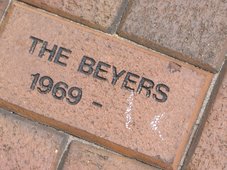Thursday, December 3, 2009
TIF Talk
At the County Council's work session on downtown development earlier this week, the conversation turned to Tax Incremental Financing.
GGP plans to seek TIF financing to help pay for improvements, principally "structured parking" for the new development.
GGP's Greg Hamm, the company's point person on Columbia redevelopment, said that in addition to serving the private offices and residences, "perhaps" the parking could be used for a new public library and "perhaps" it could be used for Merriweather and "other government uses."
"Perhaps" he didn't mean to use "perhaps" so much. After all, if the county approves a TIF it has ownership in the improvements.
Basically a TIF is a kind of financing in which bonds are paid off with a portion of anticipated tax revenue increases. So, for example, you put in a road, the surrounding real estate increases in value, and you use some of that future increase to pay off the debt.
A TIF hives off some of the anticipated tax revenues to downtown, meaning it will not go back to the general county kitty.
Getting a TIF right is important because, presumably, the county would like to keep as much future revenue unencumbered as possible, but still pay for improvements that will be needed.
So what's the right number?
No one has figured that out. We can't know what a TIF might do to revenues because we don't know yet what the final plan will be -- it is a chicken and egg dilemma, the council was told.
Except we do know what GGP proposed, but hey, why use that as a basis?
Hamm said there are many other ways to "skin the cat," and finance downtown improvements, including possible federal funds for smart growth or just using regular government general obligation bonds.
Beyond the TIF, Council chairwoman Mary Kay Sigaty asked Hamm to explain exactly what GGP would pay for.
Hamm said the company was paying for an environmental assessment of the area and GGP would put in $7 million to match CA and public funds for fixing up the Symphony Woods watershed. GGP and the builders it works with would effectively pay for higher design standards.
The company would pay for transportation feasibility studies, including interchange and transit options, and promote transit initiatives.
GGP would also contribute an unspecified sum to security and open space maintenance in the area. It would work with the county to identify possible locations for new police and fire stations -- possibly contributing funds depending on discussions with the county.
Hamm said the company pledged to also work with CA and other groups on creating a better linkage between east and west Columbia, even leaving open the possibility of a bridge between downtown and Oakland Mills.
The list goes on, but you get the idea.
GGP plans to seek TIF financing to help pay for improvements, principally "structured parking" for the new development.
GGP's Greg Hamm, the company's point person on Columbia redevelopment, said that in addition to serving the private offices and residences, "perhaps" the parking could be used for a new public library and "perhaps" it could be used for Merriweather and "other government uses."
"Perhaps" he didn't mean to use "perhaps" so much. After all, if the county approves a TIF it has ownership in the improvements.
Basically a TIF is a kind of financing in which bonds are paid off with a portion of anticipated tax revenue increases. So, for example, you put in a road, the surrounding real estate increases in value, and you use some of that future increase to pay off the debt.
A TIF hives off some of the anticipated tax revenues to downtown, meaning it will not go back to the general county kitty.
Getting a TIF right is important because, presumably, the county would like to keep as much future revenue unencumbered as possible, but still pay for improvements that will be needed.
So what's the right number?
No one has figured that out. We can't know what a TIF might do to revenues because we don't know yet what the final plan will be -- it is a chicken and egg dilemma, the council was told.
Except we do know what GGP proposed, but hey, why use that as a basis?
Hamm said there are many other ways to "skin the cat," and finance downtown improvements, including possible federal funds for smart growth or just using regular government general obligation bonds.
Beyond the TIF, Council chairwoman Mary Kay Sigaty asked Hamm to explain exactly what GGP would pay for.
Hamm said the company was paying for an environmental assessment of the area and GGP would put in $7 million to match CA and public funds for fixing up the Symphony Woods watershed. GGP and the builders it works with would effectively pay for higher design standards.
The company would pay for transportation feasibility studies, including interchange and transit options, and promote transit initiatives.
GGP would also contribute an unspecified sum to security and open space maintenance in the area. It would work with the county to identify possible locations for new police and fire stations -- possibly contributing funds depending on discussions with the county.
Hamm said the company pledged to also work with CA and other groups on creating a better linkage between east and west Columbia, even leaving open the possibility of a bridge between downtown and Oakland Mills.
The list goes on, but you get the idea.
Subscribe to:
Post Comments (Atom)





No comments:
Post a Comment